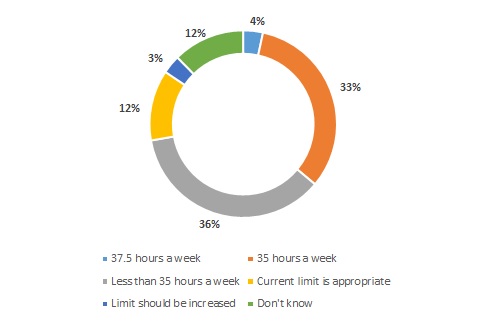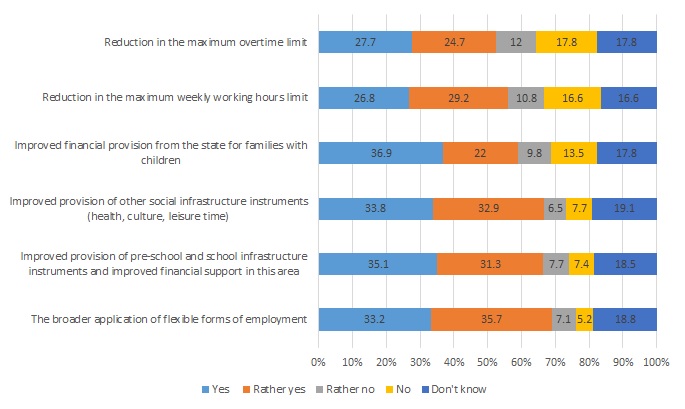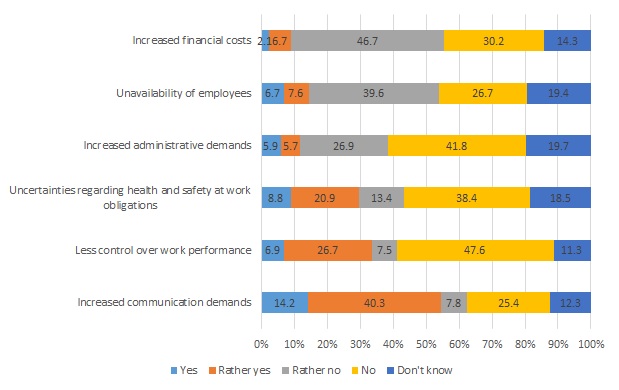There is a growing debate in the Czech Republic over moves to shorten working hours and introduce flexible forms of work to improve people’s work–life balance. This has been sparked by research showing that even though employees, especially men, tend to work long hours, labour productivity and remuneration are low.
Background
Statistics compiled from the third quarter of 2016 have revealed that the usual weekly working time in the Czech Republic is 41.7 hours. However, Eurostat data from 2015 show that work productivity per hour stood at 74.1% of the EU average. Eurostat data also show that in 2016 the Czech Republic was the eighth cheapest labour force in the EU, with an average cost of CZK 270 (€10.1 as at 15 May 2017) per employee per hour. This cost includes wages or salaries and non-wage costs such as employers’ social contributions.
Experts say reasons for the low level of labour productivity include, principally, low-paid assembly work and, sometimes, poor work organisation. Consequently, these low wages and low productivity levels have been identified as the cause of the higher number of hours worked. The low-paid labour force is the result of moves by the Czech National Bank (ČNB) to weaken the Czech currency and reduce labour costs that were among the highest in the OECD. As a result of the level of mandatory deductions, companies now have less money to finance wage increases.
Debate on shorter working hours and flexible working
A debate is unfolding on the potential for the statutory shortening of working hours and there is greater support for the introduction of flexible forms of work. However, this could lead to a fall in the standard of living for families. The low proportion of part-time jobs in the Czech Republic (6.3% in 2015) is one of the facts used to support the argument that workers rely on longer hours to get enough pay. The largest trade union organisation in the country, the Czech-Moravian Confederation of Trade Unions (ČMKOS) has, in cooperation with the Czech Confederation of Industry (SPD ČR), begun to address how working hours could be shortened without reducing salaries, and consider the impact of such a measure on competitiveness and employment trends.
This issue will be fully examined in the three-year project Shortening working hours (Zkracování pracovní doby), which began in January 2016 and will finish on 31 December 2018. The project, funded by the European Social Fund, will also try to address the effective use of flexible forms of working time.
The project aims not only to analyse the overall situation but also to address the possibility of shortening working hours without reducing wages in different regions, assessing whether this could increase regional employment. It also plans a manual and methodology for shortening working hours. The manual will be designed especially for employers and employee representatives to use during collective bargaining.
Survey on attitudes to shorter hours and flexible working
As part of the project, an opinion survey Forms of Employment (Formy zaměstnanosti) was carried out to determine what people aged 18 and above thought about shortening working hours and introducing flexible forms of work. The representativeness of the sample was ensured by means of quota sampling which fully reflected the sociodemographic structure of the population of the Czech Republic in line with Czech Statistical Office data to reflect gender, age, education and region of residence. The data were collected through an online questionnaire (CAWI) between 25 June and 5 July 2016. The research sample was made up of 8,511 people aged 18 years and over; 45% were employees, 4.3% employers and 0.8% employment agency workers. The remaining respondents were either economically inactive or were self-employed. Although there are a number of reasonable methodological objections to the internet polling method, the research can at least be considered an illustrative source on a subject that, until now, has not been monitored in the Czech Republic.
A clear majority of the respondents supported the shortening of working hours while maintaining the same level of income. The survey revealed that only 4.4% of people (mostly employers) disagreed with the statutory shortening of the maximum limit set for weekly working hours, if the level of income was maintained.
One-third of respondents stated that the statutory maximum weekly working hours limit should be reduced to 35 hours per week (see Figure 1). One-third stated that the limit should be fewer than 35 hours a week. Other research results, however, indicated that respondents were reluctant to accept this measure unreservedly. Nearly half of those surveyed (44%) were concerned that the statutory shortening of working hours would lead to an increase in labour costs and, consequently, in the cost of goods and services; nearly one-third of respondents (31%) suggested the possibility of production being moved abroad.
Figure 1: If there were a change in the statutory maximum limit of weekly working hours from 40 hours a week without a change in salary, what should the limit should be?

Note: Corresponding to the whole population 18+ (N=8.511)
Source: ČMKOS and SANEP
The authors of the survey report view reducing the statutory number of weekly working hours as a way of reducing unemployment and improving the balance between work and personal life. The general public, however, was divided on this, especially on the issue of reducing unemployment. The suggestion that a reduction in statutory working hours could help reduce unemployment was rejected by 42% of respondents (27% strongly disagreed). The same proportion of respondents (42%), however, expressed optimism that unemployment might be reduced through such a measure (18% strongly agreed). Some 15% of respondents answered ‘don’t know’.
The potential for such a measure to improve work–life balance was evaluated more optimistically. More than half of the respondents (58%) stated that a reduction in the maximum limit for weekly working hours could lead to a better balance between work and personal life; 27% disagreed, and 17% replied ‘don’t know’ (see Figure 2).
Compared with the somewhat ambiguous evaluation of measures aimed at reducing the statutory weekly working hours limit, a significantly more positive opinion was expressed about the introduction of flexible forms of employment. Respondents believed that the broader promotion of flexible forms of employment would lead to a reduction in unemployment (61% positive responses, 20% negative responses and 19% don’t know) and a better balance between personal and professional life (69% positive responses, 12% negative responses and 19% don’t know).
Figure 2: In your opinion, what measures would lead to the improved reconciliation of work and family life?

Note: Corresponding to the whole population 18+ (N=8.511)
Source: ČMKOS and SANEP
Greater requirements in terms of overall flexibility and, in particular, working time flexibility were expressed by a relatively high proportion of employees (40%), for whom their current working time patterns are unsatisfactory. Although the use of flexible working hours and flexible forms of employment is no longer exceptional in the Czech Republic, and employers are increasingly introducing such measures into their company work practices, such tools continue to be associated with certain negative features. Indeed, the research provided a glimpse of these negative aspects for employers, such as increased communication costs and less control over the work performed by their employees (see Figure 3).
Figure 3: In your opinion, what negative aspects would result for employers from the introduction of flexible forms of employment?

Note: Corresponding to employers (N=366)
Source: ČMKOS and SANEP
Discussion
The demand for shorter working time and more flexible forms of employment, especially flexible working hours and working from home, is reflected in other surveys. For example, research by the Public Opinion Research Centre (CVVM), and the Institute of Sociology of the Czech Academy of Sciences (AVČR) on state family policy measures (PDF) revealed that 9 out of 10 respondents approve of potential state support for expanding the introduction of flexible working hours and of support for part-time employment. Indeed, support for these measures is perceived much more positively than, for example, expanding the capacity of crèche facilities or expanding and increasing state benefits such as the birth allowance or tax relief.
However, shortening the statutory maximum weekly working hours, even with the support of the public, remains controversial. Arguments about reducing unemployment when businesses are struggling with a critical shortage of labour are difficult to justify. That said, statistical data on registered collective agreements (2016) tended to reflect just such a trend: half of the agreements included shortening maximum weekly working hours for all employees to 37.5 hours, and the average collectively agreed normal weekly working time stood at 38 hours. It should, however, be noted that this was confined mostly to larger industrial companies.